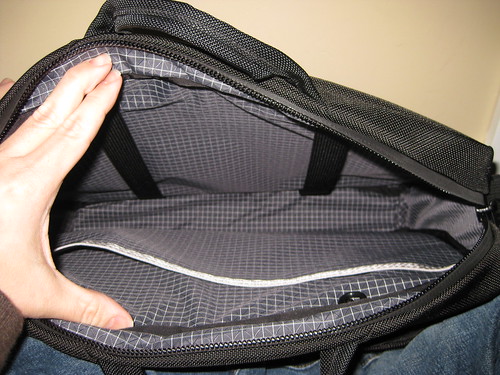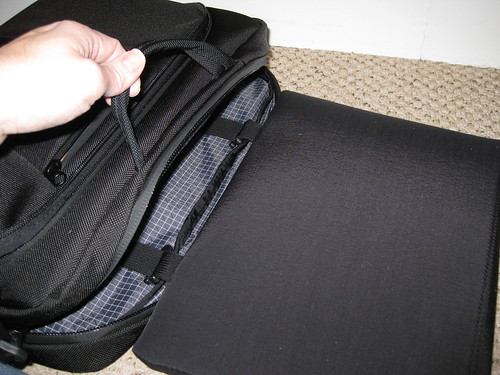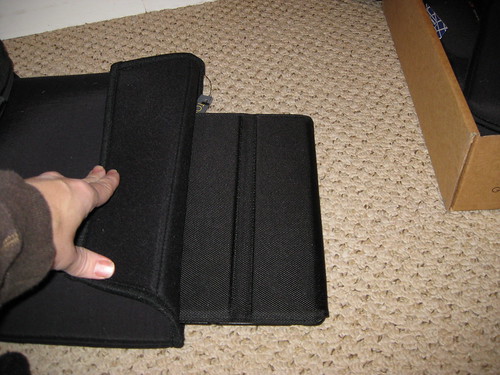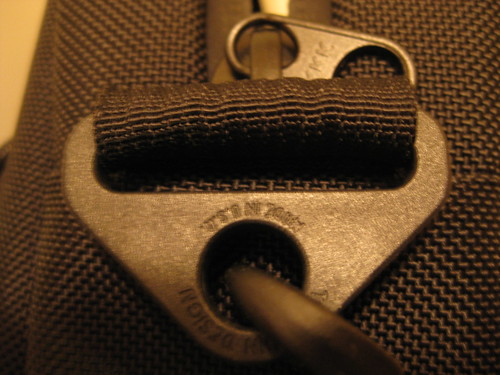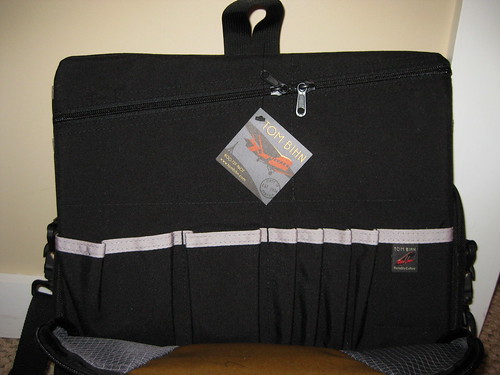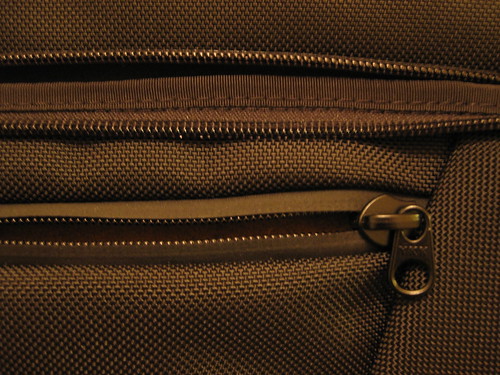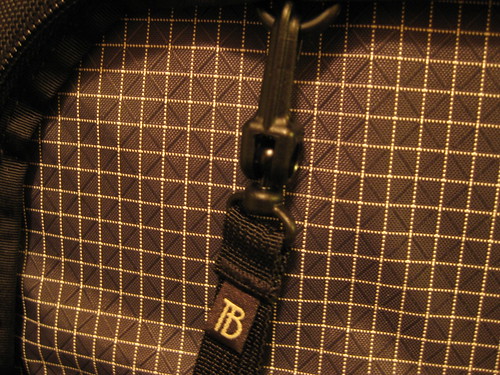Tom Bihn Cadet
After the post regarding the Most Interesting EDC products of 2011, Tom Bihn contacted me and we worked out the arrangements for a review of the Cadet. Tom Bihn is a bag company headquartered in Seattle that makes fantastic bags, with amazing attention to detail, all the while scrupulously honoring their Made in the USA label. They even go so far as to tell you when things can't be made here, such as their special Dyneema fabric, which for patent/trademark reasons, must be made in Japan. The only drawback to a Bihn bag is that they are sold only through their website or their store, which is in Seattle. If you don't live in Seattle there is really no way to get a hands on experience, aside from ordering one. Since your satisfaction is guaranteed (return the bag for full refund of purchase price within 60 days), it is not that big a deal, but still, a hands on review in this instance is really handy.
And hands on this was. I am a lawyer, a public defender actually, and I travel a lot. I am also a public defender in one of the wintriest states in the Union and all of this traveling is usually accompanied by a lot of snow and freezing rain. The Cadet subbed in for my beloved but bulky Tumi bag and did the rounds with me for two weeks. This was not some candy ass test. This was down in the trenches, getting rained on, snowed on, tugged from hearing to hearing, court to court. And the end result is really amazing--this bag looks and works great. More importantly, after this two week test, it still looks brand new.
But you need to know what you are getting into. The Cadet is tiny. I liked it because it was tiny. Tiny is good. With the advent of newer smartphones there is less of a need to carry around a bunch of bulk. But you need to know just how tiny this thing is. The Cadet gives you JUST enough space for a smartphone, and using the special sleeve, a small ultrabook or tablet, and some pens and pencils. There is a little more room for a few files or some paper, but don't expect to lug around a Pendaflex folder. It ain't gonna happen. So if you can live with those limitations, then buckle your seat belt, because this is a hell of a bag.
Here is the Cadet's product page. There are two sizes, the 15 inch Cadet (for 15 inch laptops) and an even smaller one, the 11 inch for iPads and the like. I reviewed the 15 inch Cadet. Here is a good review, though I am proud to say there are very few. There is no Amazon page because this is straight to you product from Tom Bihn. As such, there are no Amazon reviews or price variation. Here is the bag they sent me:
Here is my bag scoring system.
Design: 2
The Cadet is a small bag. A very small bag. You need to know that. If you can accept the size, then be prepared. The design is like nothing else. I have seen and used about a dozen different styles of bags and briefcases (what do you think lawyers talk about?). There is nothing, not even my uber pricey Tumi, as well laid out and as well designed. The smartphone pocket is a genius move. The pocket is placed for easy access even while wearing the bag. It also has an ultra suede lining to keep your precious phone nice and scratch free. Here is a shot of the interior of the smartphone pocket (with a helper's hand, boy these bags are hard to photograph by myself):
Design: 2
The Cadet is a small bag. A very small bag. You need to know that. If you can accept the size, then be prepared. The design is like nothing else. I have seen and used about a dozen different styles of bags and briefcases (what do you think lawyers talk about?). There is nothing, not even my uber pricey Tumi, as well laid out and as well designed. The smartphone pocket is a genius move. The pocket is placed for easy access even while wearing the bag. It also has an ultra suede lining to keep your precious phone nice and scratch free. Here is a shot of the interior of the smartphone pocket (with a helper's hand, boy these bags are hard to photograph by myself):
I also have to give kudos to how the handles meet together. However they stitched and/or sewed it, the handles seem to have magnets in them and always meet. It is a brainless motion, grabbing the bag and getting a move on. I also love the Cadet Cache. It is a little sleeve that slides inside the bag on two fabric "rails". Here is a picture of the interior and rails:
The Cache comes out for TSA check in like the tongue in your mouth (gross analogy I know, but it works perfectly). Here is a shot of the Cache hanging out:
Check the Cadet product page for a series of shots on how the Cache works. Here is a photo of the Cache swallowing my iPad (and cover):
Everything is amazingly well laid out and in the right proportion, especially the zippers, more on that later.
Fit and finish: 2
Zippers:bags as threads:flashlights as grind:knives. These are the details that tell you the overall fit and finish of a product and here the zippers are great. You can tell that everything is nicely done though, just by looking. There is no fraying or extra fabric in the interior (stuff left over after the liner is stitched in). There are no wandering threads and all of the seams are straight. Also, the fabric is tough without being like sandpaper. If Maxpedition's nylon is the toughest and Tumi's is a satiny sheet, Tom Bihn's is somewhere closer to Tumi. Tough but not 36 grit, scour-away-the-gym-floor-varnish tough.
Carry: 2
Small bags are easier to carry, duh. But this bag with the meet-together handles and well balanced pockets is a dream. One thing that a lot of less attentive bag makers do is position the latches for the shoulder strap near the mid line of the bag. This means that sometimes the bag is inverted when you pick it up and the contents spill all over the place. Here, Tom Bihn, who personally designs every bag, put the shoulder strap latches in the right place, about 3/4 of the way up. High enough to prevent a flip over, but not so high as to impede the zipper or access to the bag while it is being carried.
Materials: 2
This is one of the place where I wish I could give the bag a 3. With the Tumi bag there was no question it was bomb proof, but I feel like there was less thought put into what was used. Everything is strong, tough, and heavy, whether it needs to be or not. Here Bihn used the best materials for the job. On the exterior he used tough but not rough nylon. In the interior he used the Dyneema fabric mentioned above. The shoulder strap latch is made out of what looked like Delrin, a super tough but super light plastic. The Delrin piece shows an approach to the bag that differs from that of Tumi's approach. The overall bag is considered in the selection of each and every part and the materials in those parts. Here is the Delrin (or Delrin-like) latch:
Sure a metal latch would work, but is it necessary? No. You save weight there and lose nothing, really, in terms of performance. Metal is stronger, of course, but Delrin is more than strong enough in this application.
Accessibility: 2
The zipper to the main pouch does not open as wide as my Tumi bag's does, but surprisingly, this was never an issue. The pen pouch is also very easy to get to, and the smartphone pocket is simply sublime in its placement, accessibility, and design. Again, everything evinces an attention to detail.
Ease of Packing: 1
Okay, here is a sticking point for me. Two things, first, the zipper for the main pouch, as mentioned above, does not travel all that far, probably around 1/3 of the total circumference of the bag. The Tumi bag's zipper, like many laptop bags, travels much further allowing for vastly easier packing. Second, the Cadet Cache eats up a lot of space in the main compartment and when full makes packing more difficult. It is not hard, not by any means, but this is one place where the bag fell short. Even more problematic, there is nothing inherent in the small design that makes this NECESSARILY an issue. Little more travel on the zipper and a little smaller Cache and things would be fine. One problem is the Cache really doesn't close. Instead it folds over and tuck in, meaning there is a lot of material bunched up near the opening of the bag when the Cache is in use and closed. A magnetic closure or a zipper on the top of the Cache would prevent this problem.
Okay, here is a sticking point for me. Two things, first, the zipper for the main pouch, as mentioned above, does not travel all that far, probably around 1/3 of the total circumference of the bag. The Tumi bag's zipper, like many laptop bags, travels much further allowing for vastly easier packing. Second, the Cadet Cache eats up a lot of space in the main compartment and when full makes packing more difficult. It is not hard, not by any means, but this is one place where the bag fell short. Even more problematic, there is nothing inherent in the small design that makes this NECESSARILY an issue. Little more travel on the zipper and a little smaller Cache and things would be fine. One problem is the Cache really doesn't close. Instead it folds over and tuck in, meaning there is a lot of material bunched up near the opening of the bag when the Cache is in use and closed. A magnetic closure or a zipper on the top of the Cache would prevent this problem.
Pockets/Organization: 2
Nothing wrong here at all. The pen pocket is plenty big with tons of dividers and spacers. The smartphone pocket, as you can probably guess by now, is amazing. Even the main pocket, with the Cache on rails is pure genius.
Also, Tom Bihn sent me a bevy of accessory bags and packs. Many of these are even more helpful in organizing your stuff, I'll go through more below, but one was so nice and large that it is more like a second pocket than an accessory. The Fruedian Slip, was quite nice. Here is a pic:
The idea is that you can drop it in the bag and load it up with stuff, like a second pen pocket, or you can fill it with things with the intention that it come out. I can see this being useful for folks that work on a job site, like an architect, who might carry it in the bag to the site, and then set up a mini work station once there and hang the Slip somewhere for easy access. As a lawyer I couldn't take full advantage of this really innovative indepedent pocket, but I can see how some would love it. Mind you, this makes the main pocket feel even smaller though.
Snaps/buckles/zippers: 2
Okay before I get into it, here is a picture of the Tom Bihn zipper:
This really had me scared. Typically when zippers have seals or covers they do nothing but snag the pull over and over again. Instead of the normal OVER the pull design, Tom's zippers have a cover that slides THROUGH the pull. I was still wary of jamming, but in my two weeks of significant use, there was never a snag or a hitch at all. If these zippers hold up over the years, they are a massive leap forward from the standard zipper. They are smooth as glass in use and they really do lock out the elements. Water is not so much of a concern, but the big issue for me is snow. Sometimes, when shuttling from court to court I would brush up against a car or a tree and the zipper's path would be crusted with snow. The Bihn zippers make this scenario no probably at all. Just brush off the snow and your good to go. There is no fear or concern that debris or ice will fall into the teeth and jam the mechanism. In fact, this ingenious cover makes the zippers significantly easier to use in all weather. If ice is kept out in the winter, there is very little chance that dust or dirt will lodge in the zipper in the summer.
The snaps are fine, strong and easy to use. One snap in particular will take a bit of time to get used to and it is the "Gatekeeper" snap used on the rails for the Cadet Cache. Here is the snap up close:
These little boogers are tough to unclip, and for good reason--they are the only thing holding the Cadet Cache and your laptop in place. But they function well once you learn the trick. You have to pull the metal gate out of the way a bit in order to be able to pinch the latch open. There are other clips for attaching accessories, seen here:
and they work very well. I like the ball-and-socket connector as well as the myriad of connection points (little o-rings of plastic) anchored throughout the bag. Only the Gatekeepers were hard to use and they were designed to be that way so your laptop doesn't fall out. The rest of the latches and connections were great.
Straps and belts: 1
Here is the Achilles heel of this otherwise brilliant bag. Tom Bihn including their premiere strap, the Absolute Strap, in my review sample. It was only okay. In comparison to the new Tumi strap, it was not that good at all. First, the actual shoulder pad portion is covered on the bottom with extra tacky rubberized material (like the underside of a mouse pad). This is good at keeping the bag put, but it is a little TOO grippy. When I was wearing a suit, which is everyday, the pad would wrinkle the suit. On occasion, it would almost pull my suit jacket off when I would remove the bag. A simply suede leather underside on the pad would be more than grippy enough and still be durable and comfortable. If it were not for the great clips, I would have given the Cadet a 0. Even these clips, though, do not compare to the inspired design of the Tumi clips on their new shoulder strap. And here is the capper--all of these comparisons to the Tumi bag usually come out in favor of Tom Bihn because of cost (the Cadet is well less than half the cost of my Tumi bag), but here, their strap is only $5 less (here is the strap I have, at $35).
Modularity/expansion: 2
Again, if I could, I would give this bag a 3 for modularity. There is a reason people love the basic and simple Kifaru bags. They have a billion different accessories and attachment points. Tom Bihn's bag is the same way. They sent me probably $150 worth of pockets and accessories and all of them work well. I didn't use a whole lot of them, but if you were a traveler or an on-site guy or gal, these would be incredibly useful. The Cadet Cache and the Fruedian Slip stand out among the bevvy of bags, but all were decent. They do add up quickly, but if this is your bag, spending the extra dough will only make it nicer.
Overall Score: 18 out of 20
Well, if you can do the bag limbo in terms of contents (how low can you go) you will be amply rewarded by buying the Cadet. It is slim, beautiful, tough, and easy to use. It can be tricked out with accessories until every thing as a place and every place has a thing. It is easily in the same class as Tumi stuff, maybe a little less tough, but in every way other than the strap, superior in design. I honestly don't think that durability is an issue and I would much rather have less weight. This bag turned out to be a little TOO small for me, but it has sold me on the Bihn philosophy of quality and commitment to good design. And all of this is made in the USA. If you are in the market for a new laptop bag or a briefcase Tom Bihn should be at the top of your list. If this guy sounds too small check out either the Zephyr or the Empire Builder. Also, if you order one, be sure to order it with the high visibility interior fabric. I don't know why all bags don't come with this standard, but Tom's bags can. Thanks to Tom Bihn and Darcy for sending me a review sample.
Well, if you can do the bag limbo in terms of contents (how low can you go) you will be amply rewarded by buying the Cadet. It is slim, beautiful, tough, and easy to use. It can be tricked out with accessories until every thing as a place and every place has a thing. It is easily in the same class as Tumi stuff, maybe a little less tough, but in every way other than the strap, superior in design. I honestly don't think that durability is an issue and I would much rather have less weight. This bag turned out to be a little TOO small for me, but it has sold me on the Bihn philosophy of quality and commitment to good design. And all of this is made in the USA. If you are in the market for a new laptop bag or a briefcase Tom Bihn should be at the top of your list. If this guy sounds too small check out either the Zephyr or the Empire Builder. Also, if you order one, be sure to order it with the high visibility interior fabric. I don't know why all bags don't come with this standard, but Tom's bags can. Thanks to Tom Bihn and Darcy for sending me a review sample.



